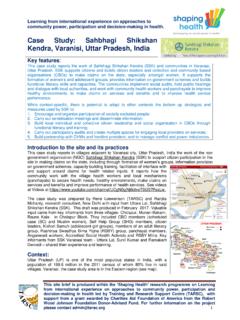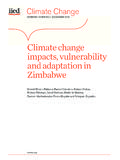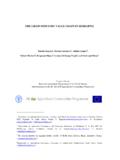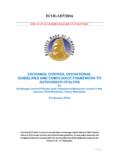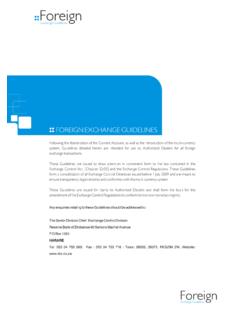Transcription of Community views on the essential health benefit in ...
1 Community views on the essential health benefit in zimbabwe REPORT Training and Research Support Centre (TARSC) working with Ministry of health and Child Welfare and Community based researchers January 2013 Harare, zimbabwe With support from OSF / OSISA TABLE OF CONTENTS Executive Summary .. 3 1. Background .. 5 Defining comprehensive health care entitlements .. 6 2. Objectives of the assessment .. 7 3. Methods .. 7 Study design .. 7 Data Collection .. 8 Data quality and analysis .. 10 Ethics and permissions .. 10 4. Findings .. 10 Major health need and problems.
2 10 Prioritised services .. 13 views on payments for services .. 18 5. Discussion and conclusions .. 20 Appendix 2: Additional data from the PRA meetings .. 22 Appendix 3: Additional data from the questionnaire .. 27 Cite as: Training and Research Support Centre (TARSC) (2012) Community views on the essential health benefit in zimbabwe January 2013: TARSC Harare Rene Loewenson contributed to the design, tools, analysis and reporting Artwell Kadungure contributed to training, field work, analysis and reporting Percy Mcijo, Audrey Titos, Melba Kasambira, Lewis Chitovoro, Douglas Shokoni, Patty Punungwe, Pfungwa Maringe, Tirivangani Paguti, Stephen Marima, Nyadzai Chinokwetu, Petra Adam, Shelly Kabanda, Mercy Muradzikwa, Zenzele Moyo, Sithabile Moyo, Lydia Maphosa, Tracy Ndlovu, Norma Zhou, Patrick Jengwa contributed to the field work Senele Dhlomo and Zvikie Mlambo contributed to the training Acknowledgements.
3 We acknowledge with thanks the review input from MoHCW (Dr D Dhlakama, Dr G Mhlanga) and UNICEF (Mr G Musuka) on the protocol, the permissions from MoHCW and the co-operation of local health systems and communities and in particular the Civil society organisations in the CMCC (ZIMTA, CFH, ZCTU) for organising the Community based researchers. Thanks to OSF for financial support for the work. Executive Summary The zimbabwe government in its National health Strategy 2009-2013 proposed to review the provision of the basic entitlements to health . In the February 2012 a national stakeholder meeting on the zimbabwe Equity Watch, participants agreed that defining comprehensive health care entitlements calls for technical and policy dialogue (including with Parliament and civil society) to establish, cost and raise awareness on a clear set of comprehensive healthcare entitlements for the population at the various levels of the health services.
4 As a starting point it was proposed that the District core services defined by MoHCW in 1995 need to be updated; initially at Community , primary and district level- against the current epidemiological profile, be subject to review and input from communities and sectors that provide public health inputs, and be costed in various provinces, at various service levels ( Community , primary and secondary levels) and by various providers (central, local government, missions and other private). An assessment was thus implemented in late 2012 by Training and Research Support Centre, working with review input from Ministry of health and Child Welfare and with Community based researchers from various civil society organisations.
5 The assessment aimed to determine Community , local leaders and frontline workers views on key areas relevant to the framing of the essential health benefit (EHB). The assessment aimed more specifically to determine; a. priority public health problems the EHB should address and any important features of their distribution by social and economic groups that services need to respond to. b. the services for health promotion, prevention, PHC, treatment and care, rehabilitation and palliative care that communities expect to see in place at Community , primary and district level that would (i) address these priority health needs (ii) fulfill the constitutional right to health services, and c.
6 The roles and contributions of ministry of health , other ministries, other agencies and of communities (households, communities and leaders) in providing these services. A cross sectional design was used. Data collection was implemented through a one day Participatory Reflection and Action (PRA) meeting of between 30-50 people and an interviewer administered questionnaire with households, representatives of Community based organisations, Community leaders and Community level workers. The assessment was implemented in three urban and seven rural districts from all the ten provinces of zimbabwe .
7 A total of 315 people participated in the PRA meetings and 601 in the questionnaire. Respondents identified the major health needs and problems in zimbabwe for which services should be provided for ALL people, no matter where they live or what social or income group they come from. Results indicate that there was Equal concern for services to address diseases and to address the social determinants of health (SDH), and in the latter particularly access to safe water, adequate food and safe transport Concern for both communicable and non communicable diseases (NCDs), including the health promotion activities for managing these A link between the diseases and SDH raised (eg cholera, typhoid and water, sanitation Continued prioritization of HIV and AIDS as a major concern Similarity between Community and health workers views Greater focus amongst CBOs on AIDS than other needs and low public health focus, and Greater concern in urban communities on non communicable diseases (NCDs).)
8 Particular issues were raised for specific groups, with serves prioritised for diarrhoeal diseases, nutrition and abuse in children, for sexual and reproductive health (SRH) in adolescents; for SRH and maternal health in women and for hypertension, diabetes, cancer, eyesight and hearing loss, kidney and liver problems and mental health in elderly people. In relation to prioritised services, the findings showed that Certain services were expected to be delivered at all levels, including health education, SRH, nutrition services, environmental health , treatment for endemic communicable and NCDs, and psychosocial support.
9 At Community level, respondents gave a strong focus to environmental health , management of key social determinants such as road transport; solid waste; herbal gardens; social and spiritual support; dissemination of information on prevention and management of abuse; and home based care, disease control and nutrition activities and having accessible medicines in Community level services At clinic level, in addition to areas prioritized at Community level, respondents also noted that frontline services should screen for NCDs (eg blood pressure monitoring, diabetes and cancer screening) and for communicable diseases, (eg TB tracing); respond to major health issues, ie VCT,PMTCT, ART and DOTS; Pre-natal, post natal care, immunisation, delivery services; growth monitoring and nutrition.
10 Quarantine communicable diseases, ensure available medicines and personnel for prevention and treatment of endemic and other diseases; ensure water, sanitation and good hygiene at the clinic; train VHWs, provide counseling services and transport for referrals to district hospitals. In district hospitals while these issues are noted, so too was quarantine and management for infectious diseases; HIV/AIDS/TB testing and diagnostic services; family planning, VCT, condom distribution, support for health lifestyles/ exercise; medicines for communicable and NCDs; provision of specialist doctors, dental care, pharmacy; chemotherapy, physiotherapy, mental health , herbal medication and mortuary services, cancer screening and treatment; surgery, delivery of complicated pregnancies and training of district personnel such as health promoters.








